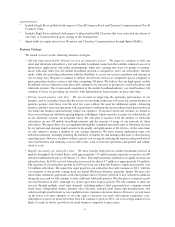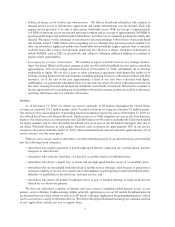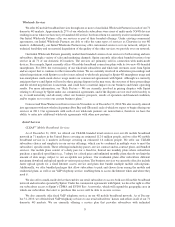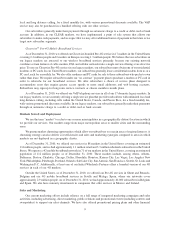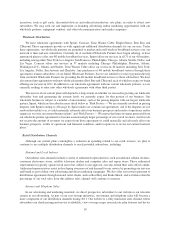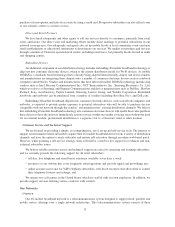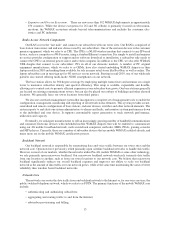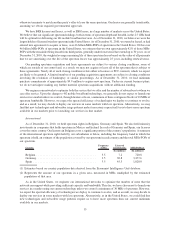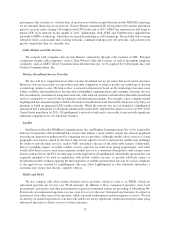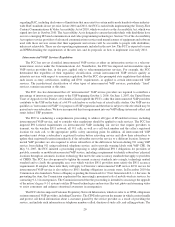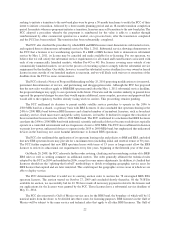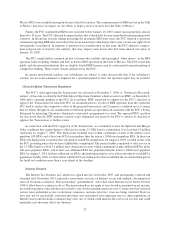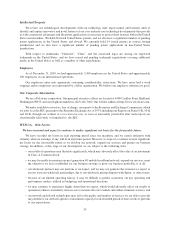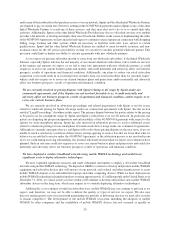Clearwire 2010 Annual Report Download - page 21
Download and view the complete annual report
Please find page 21 of the 2010 Clearwire annual report below. You can navigate through the pages in the report by either clicking on the pages listed below, or by using the keyword search tool below to find specific information within the annual report.The International Telecommunications Union has approved the technical requirements for 4G technology and
has recommended that 4G technologies need at least 40 MHz of spectrum, and preferably up to 100 MHz of
spectrum in each market, regardless of the frequency used, in order to provide sufficient channel width to enable the
data throughput that 4G mobile broadband services will demand. Our current spectrum holdings in most of our
planned markets in the United States and in most of our international markets satisfy these standards.
Research and Development
Our research and development efforts have focused on the design of our networks, enhancements to the
capabilities of our networks and the evolution of our service offerings. A significant portion of our research and
development efforts involves working with the suppliers of our network infrastructure and subscriber equipment.
We are currently working with Intel, Motorola, Samsung, Huawei Technologies Co., Ltd, which we refer to as
Huawei, Cisco Systems Inc., which we refer to as Cisco, and other vendors to further develop network components
and subscriber equipment for our 4G mobile broadband network.
Our research and development focuses on three key areas, which include technical requirement assessment,
network and performance validation, and interoperability testing, spanning access, backhaul, “Core” (i.e., the
central aggregation points for our network), devices/chipsets, and back office systems. We continue to work toward
improving the performance and functionality of this technology and products through our ongoing research and
development activities. Several evolutionary products are currently in the early stages of development with RAN
partners, including, among others, multi-carrier power amplifiers, remote radio head solutions, high power
picocells (which are base stations designed to cover a small area, such as within office buildings, shopping malls
and airports), and beamforming solutions; however, there can be no assurance that these products will be developed
as planned, or at all.
Suppliers
For our 4G mobile broadband network, we are using a number of suppliers for our network components and
subscriber equipment, including Motorola, Samsung, Huawei, Intel and Cisco, among others. Motorola is currently
the only supplier of certain network components and subscriber equipment for the Expedience system deployed on
our Pre-4G network. Because we will not be building any more markets with Pre-4G technology, the potential
adverse impact of Motorola’s position as our sole supplier of such network components and equipment is expected
to be reduced.
We are also parties to a Customer Care and Billing Services Agreement with Amdocs Software Systems
Limited, which we refer to as Amdocs, under which Amdocs is the exclusive provider of a customer care and billing
platform for both our retail and wholesale businesses.
Competition
The market for broadband services is highly competitive and includes companies that offer a variety of
services using a number of different technological platforms, such as 3G cellular, 4G, cable, DSL, satellite and other
emerging technologies. We compete with these companies on the basis of the ease of use, portability, speed,
reliability, and price of our respective services.
Our principal competitors include other wireless providers, cable and DSL operators, Wi-Fi, other 4G service
providers, satellite providers and others.
Cellular and PCS Services
Cellular and personal communications services, which we refer to as PCS, carriers are seeking to expand their
capacity to provide data and voice services that are superior to ours. With their existing 2G and 3G networks, these
providers have substantially broader geographic coverage than we have and, for the foreseeable future, than we
expect to have. Furthermore, several of these carriers have begun deploying or have deployed 4G services on their
networks. Carriers such as AT&T Inc., which we refer to as AT&T, and Verizon Wireless Inc., which we refer to as
Verizon Wireless, among others, have either begun to deploy, or announced plans to deploy, LTE, which may deliver
16


